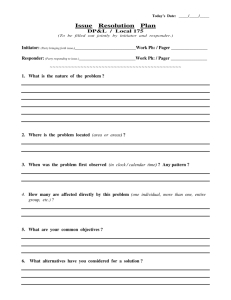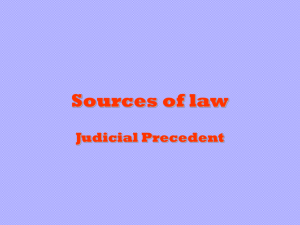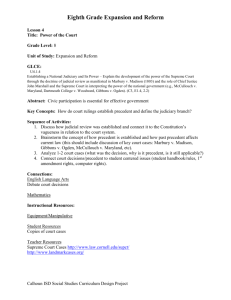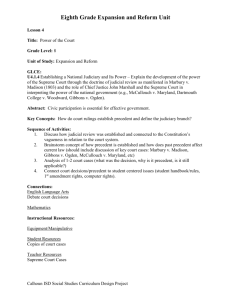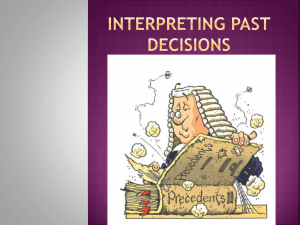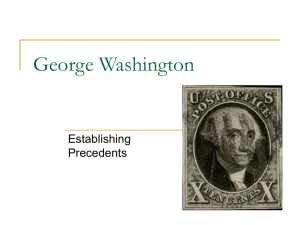Common Law
advertisement
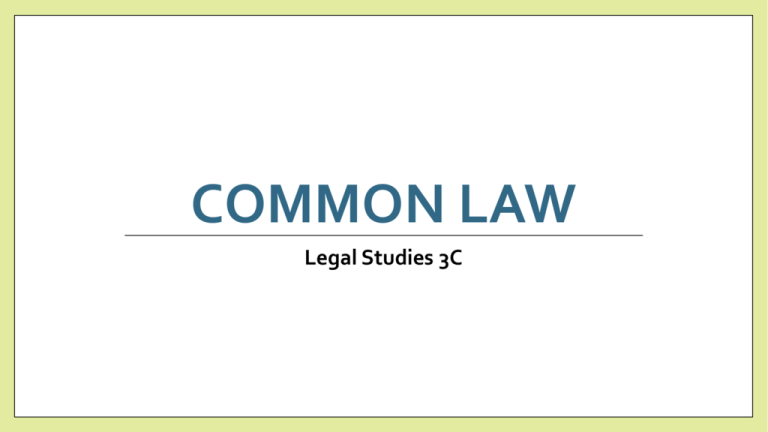
COMMON LAW Legal Studies 3C Sources of law in Australia Common law Parliament • Judge-made law Statute law or Acts of Parliament Courts Statutory interpretation Independence of the judiciary Doctrine of Separation of Powers Executive Legislative Judiciary Court Hierarchy – Tasmania High Court of Australia (Original or appellate jurisdiction) Full Court of the Supreme Court (Appellate jurisdiction) Court of Criminal Appeal (Appellate jurisdiction) Civil law Criminal law Supreme Court (Original jurisdiction) Court of Petty Sessions Youth Justice Division Magistrates Court Civil division Coronial Division Appeals in Tasmania Appeals • Matters heard in the Magistrates Courts and Tribunals can be appealed to the Supreme Court where they will be heard by a single judge. These are called Lower Court Appeals. Lower Court Appeal decisions can be appealed to the Full Court of the Supreme Court of Tasmania (for civil cases) and the Court of Criminal Appeal (for criminal cases). These appeals are heard by three judges of the Supreme Court. • Appeal cases from both the Court of Criminal Appeal and the Full Court can then be appealed to the High Court. The High Court's decision is final and no further appeal can be made. • http://www.courts.tas.gov.au/about_us/organisation Federal Courts Federal Courts High Court • High Court (1 Justice) • • Original jurisdiction Federal Law matters • • • • • • Original jurisdiction Appellate jurisdiction (Federal, Family, High Courts) Full Bench of the High Court (5 – 7 Justices). Original jurisdiction - Interpretation of the Constitution Appellate jurisdiction Family Court (original jurisdiction) • Full Court of the High Court (no less than 2 Justices) • • • • • Divorce Marriage Bankruptcy Children (parenting disputes) Property Full Court of Family Court (appellate jurisdiction) • Federal Court (original jurisdiction) • • • • • • Trade Practices Corporate Law Taxation Immigration Native Title Full Court of Federal Court (appellate jurisdiction) Appeal to High Court Independence of the judiciary • Why is this important? • Ensures fair and impartial trial for all citizens (judge is an impartial umpire) - natural justice • Ensures governments do not exceed their power and that governments are subject to the rule of law (check on executive power). • Interpret the Constitution and legislation (statutory interpretation) • Create legal principles to resolve disputes (when the issue has not been legislated on) Role of the courts • Settle disputes that arise in the community, therefore apply existing laws to the facts in cases that come before them. • Common law – when a legal principle is established by a court due to limited statute law from parliament in an area of law. This includes when a new issue is brought before the court in a case or when a previous principle of law requires expansion to apply to a new situation. • Statutory Interpretation – interpreting the meaning of the words in an act of parliament when applying them to a case the court is hearing. When can judges make law • If a case is brought before a superior court • If there is no previous binding decision in a higher court in the same hierarchy that must be followed by the lower courts. Doctrine of Precedent • When a court makes a decision in a case that is the first of its kind, the court is said to be setting a precedent. • A precedent is the reasoning behind a court decision that establishes a principle or rule of law that must be followed by other courts lower in the same court hierarchy when deciding future cases that are similar. • This creates consistency and predictability • The process of judges following the reasons for the decisions of higher courts is at the heart of the doctrine of precedent. • Precedent example - handout Doctrine of Precedent • Stare decisis – another way of describing the process of lower courts following the reasons for the decisions of higher courts. • Means – ‘to stand by what has been decided’. Doctrine of Precedent Reason for the decision = ratio decidendi • Ratio decidendi is the binding part of the judgement – the reason for the decision which is then regarded as a statement of law to be followed in the future. Read page 230 – 233 (blue), Page 221 – 223 (red) Read the following cases: • Shaddock v Parramatta • Pinkstone v R • Q1: What were the ratio decidendi in both cases (what was the precedent set)? • Q2: What was the decision and penalty in both cases? • Handout – How judges make law Doctrine of Precedent Binding precedent For the precedent to be binding, it must be: • From the same hierarchy of courts • From a superior court (higher in the hierarchy) To be considered binding on a new case: • The main facts of the precedent are similar to the main facts of the new case • The precedent was set in a higher court in the same hierarchy as the new case. • Example: Pinkstone v R (2004) – binding precedent on similar case • Example: precedent set in the High Court – the ratio decidendi is binding on lower courts in the court hierarchy Doctrine of Precedent Persuasive precedent A precedent that is not binding on the courts however as they are seen to be noteworthy and highly regarded propositions of law they may be considered by some courts as influential on their decisions. Includes: • From courts in another hierarchy (other state or country) • From courts on the same level of hierarchy (which are not binding) • From inferior courts (courts lower in the court hierarchy) Doctrine of Precedent Read page 233 -236 (blue), Page 223 – 226 (red) Read the following cases: • Example: Donoghue v Stevenson • Example: Grant v Australia Knitting Mills • Q1: What aspect of Donoghue v Stevenson (UK 1932) was used as persuasive precedent in Grant v Australian Knitting Mills (1936)? Persuasive precedent comparison Donoghue v Stevenson Grant v Australia Knitting Mills A consumer purchased goods A consumer purchased goods Mrs Donoghue did not have a contract with the manufacturer Mr Grant did not have a contract with the manufacturer There was a snail in the bottle Underwear contained chemical residues The bottle of ginger beer had been carelessly prepared The underwear had been carelessly prepared The ginger beer manufacturer could have reasonably foreseen that damage would result from the carelessness The underwear manufacturer could have reasonably foreseen that damage would result from the carelessness. Mrs Donoghue was closely and directly affected by the actions of the manufacturer Mr Grant was closely and directly affected by the actions of the manufacturer Mrs Donoghue suffered gastroenteritis and shock Mr Grant suffered dermatitis Doctrine of Precedent Obiter dictum • “Things said by the way” • Sometimes a judge will make a statement that is not part of the reason (ratio decidendi) for the decision, but is an important statement relating to the main issue of the case. This statement is known as obiter dictum, and can influence decisions in the future (persuasive precedent) • Example: Hedley Byrne & Co Ltd (B=P236, R=P227) • https://www.youtube.com/watch?v=hjPtEWzMRbA Precedent - activities • Read page 230 – 237 (Blue edition) • Read page 221 – 227 (Red edition) • Activity –You be the judge (precedent of Grant v Knitting Mills) Precedents Ways judges can develop precedent or avoid following an earlier decision • Distinguishing a precedent – court decides the main facts of new case are sufficiently different to previous case (where precedent was set) therefore precedent is not binding. • Case: Davies v Waldron (1989) (B=P238, R=P229) Precedents • Reversing a precedent (in the same case) – on appeal, the higher court makes a different decision than a lower court in the same case therefore precedent set by superior court is binding. • Case: Queen v Tomas Klamo (2008) (Blue = P240, Red = P231) Precedents • Overruling a precedent – higher court decides not to follow an earlier precedent of a lower court in a different case. The higher court decision creates a new precedent. • Case: Aon Risk Services Aust v Australian National University (2009) – (Blue p241, Red p231) • Disapproving a precedent – court expresses disapproval of previous precedent but is bound by it if in an inferior court. If previous decision has been made in a court at the same level in the court hierarchy, and the court disapproves of the earlier decision, present court is not bound to follow precedent. • Case: State Government Insurance Co v Trigwell & Ors (1978) Activity • https://www.youtube.com/watch?v=QSA1Q422r-8 • Read page 238 – 247 (blue edition) • Read page 227 - 235 • Handout – Learning Activity 1 (match the terms) • Handout – Activity 11.5 (Essential VCE Legal Studies Units 1&2) Textbook activities • Learning Activity 5.3 • • Q9 Q10 Statutory Interpretation • Tas Dams case • Deing v Tarola (the studded belt case) • • https://www.youtube.com/watch?v=Vb9JjncNq3k • Final clip to watch
